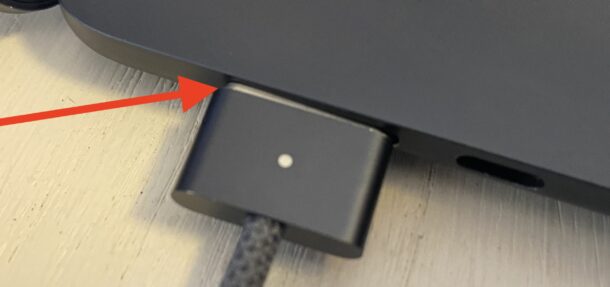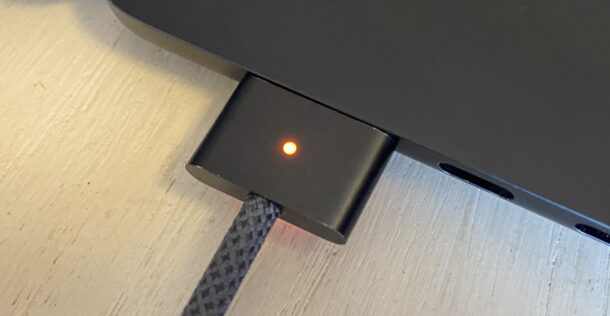Fix a MacBook Air Not Charging When Plugged In

MacBook Air is a fantastic laptop from Apple that is also very popular, with untold numbers of users around the world. While most people will never run into issues charging their MacBook Air, issues can happen where the MacBook Air does not charge when it is plugged in.
If you find that your MacBook Air battery is not charging when it is plugged in, read along with some troubleshooting steps to resolve this issue quickly.
1: Check Your Power Source
This might seem obvious, but the first thing you want to do is check that your power outlet is working.
Plug in another device to the same outlet, does it work? If the outlet doesn’t work, then it will not be able to charge your MacBook Air.
2: Inspect Power Adapter & Cable for Damage
The next thing you’ll want to do is to physically inspect the power adapter and cable that is connecting to your Mac and to the wall.
If there’s any damage to the cable, or the charger itself, it may need to be replaced before it will charge the MacBook Air successfully.
3: Inspect MagSafe / USB-C Charging Port
Next up; physically inspecting the MagSafe port and/or USB-C port. You need to make sure the charger port on the MacBook Air is free of obstructions, debris, grime, dust, or anything else that could prevent a solid connection between the charger and the port.
It’s actually fairly common for a piece of lint or other debris to get stuck in the MagSafe port or a USB-C port, which then prevents charging. Give the ports a close inspection.
Sometimes it’s obvious when something is blocking the port, because the cable or connector itself will not be flush with the Mac.

As you can see in this picture, the MacBook Air shown was not charging because the MagSafe connector was not fitting properly in the port. The reason? A little piece of lint got stuck in the MagSafe port, probably from when the MacBook Air was being stored in a bag, and it was preventing the MagSafe adapter from seating properly.
This particular type of issue is not particularly new, as it’s not unusual for stuff to gum up the MagSafe ports on new MacBooks and old alike, so don’t skip inspecting the ports.
4: Try a Different Port
If you use USB-C charging, try a different USB-C port. If one USB-C ports to charge the MacBook Air, but another doesn’t, it may be because of obstructions or other issues as already discussed, or it’s possible there’s a hardware problem with the port itself.
The easiest way to rule out issues with a particular port is to try a different charging port.
5: Try a Different Charger
Try using a different charger on your MacBook Air. Use a different USB-C charger, or a different MagSafe charger, does it work now? If so, that may indicate that your other charger is the issue.
If your MacBook Air supports MagSafe charging, try using a USB-C charger instead. Does that work to charge the MacBook Air? If so, then you know the issue is something to do with the MagSafe port; maybe it’s dirty, obstructed, there’s an issue with the cable itself, or rarely, there’s a problem with the hardware.
6: Disconnect & Reconnect Charger
A simple troubleshooting trick that often fixes issues where MacBook Air doesn’t charge is to disconnect the charger from the laptop, wait a few seconds, then reconnect.
This often remedies situations where the charger either wasn’t recognized, or needed to be re-seated in the port, before a charge could pass through.

7: Restart the Mac
If your MacBook Air continues to not charge, despite having no issues with any of the power cables, ports, or power source, then the next thing you should do is restart your Mac.
Go to the Apple menu > and select Restart.
Often rebooting a Mac will resolve curious issues, including problems with charging battery or getting power.
8: Install System Software Updates
If you haven’t done so already, check for and install available MacOS system software updates to your MacBook, and install them.
Many MacOS software updates will include firmware updates, or bug fixes, and these can resolve known issues with charging or connections.
Go to Apple menu > System Settings > General > Software Update, and proceed to install any available system software updates on the Mac.
9: Still Having Problems? Consult Apple Support
If you’re still having issues charging your MacBook Air, or your MacBook Air is not charging when it is plugged in, and you’ve tried all of the above steps, it may be time to reach out to Apple directly for help. Apple Support can help to diagnose hardware problems.
If your MacBook Air is a year old or less, you will have a year of support and warranty service to cover issues with hardware.
If your MacBook Air has extended AppleCare coverage, you will have a few years of support and warranty covered for issues with hardware.
You can reach out to official Apple support from https://support.apple.com or by contacting Apple’s support number.
You can also go into any Apple Store, or any Apple Authorized Service Provider, and have them take a look at your MacBook Air, and to diagnose and fix issues.
–
I personally ran into this recently with my MacBook Air 15″ model, where I was connecting the MagSafe charger to the MacBook and it was not charging, and these are the steps I took to remedy the problem. Now my MacBook Air charges as expected again, so these troubleshooting tricks work for most situations where a MacBook is not charging the batter as expected.
Did the above tips resolve your issues with a MacBook that would not charge when connected to MagSafe or USB-C? Did you find another solution to your charging problem? Let us know your experiences and thoughts in the comments.


Mine stopped at 80%. When I logged in, it told me I’d only been using it recently when plugged in, so more was unness. I ran it a few minutes on battery, then quit and plugged in. It promptly charged up to 100%
Apple has been doing this with most of their products. With the type of battery, it’s usually best to keep them between 20% and 80%. Apple devices will usually charge to about 80%. For example, once it learns your behavior on an iPhone. When you plug in your phone over night it will charge to 80% and keep it there until you normally wake up. So if you have it set to wake you up at 7am, it will charge to 100% before then and have the phone ready at 100% when you awake. I normally have my MacBook Pro plugged in, so it usually keeps it charged to 80%.